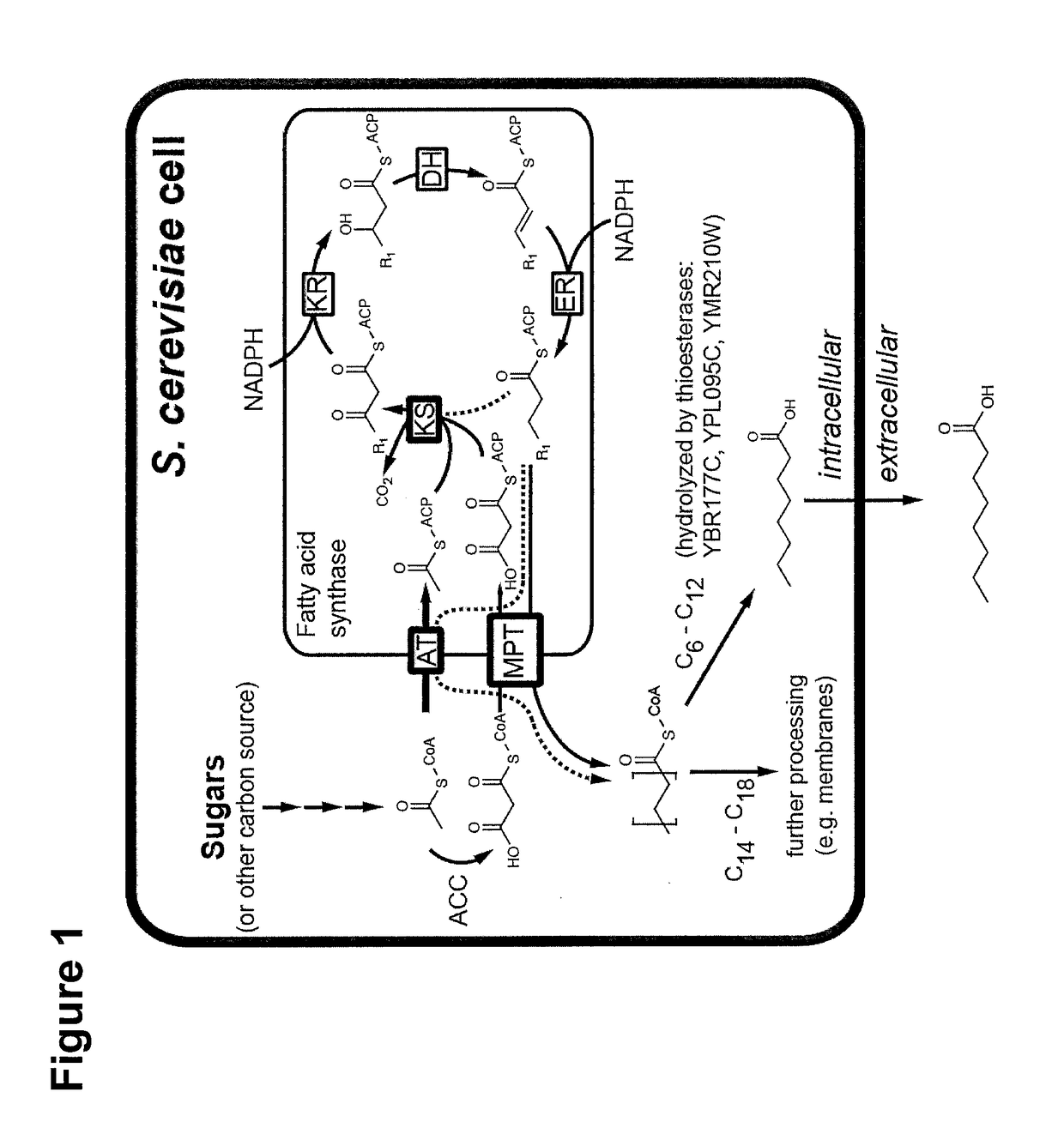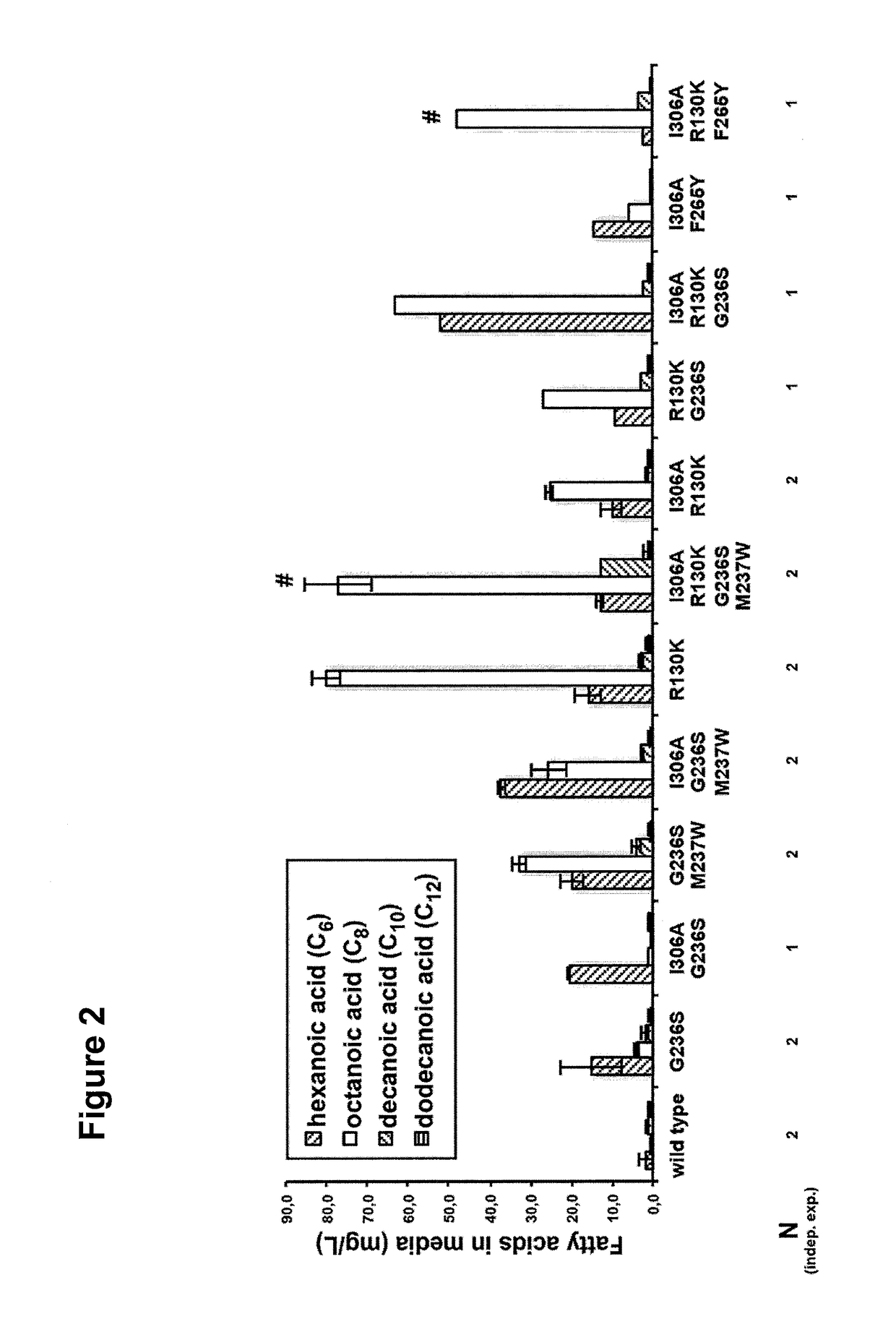Microbiological production of short fatty acids and uses thereof
a technology microorganisms, applied in the direction of biofuels, enzymology, transferases, etc., can solve the problem of difficult to achieve rational engineering for the production of short fatty acids
- Summary
- Abstract
- Description
- Claims
- Application Information
AI Technical Summary
Benefits of technology
Problems solved by technology
Method used
Image
Examples
example 1
[0812]1. Materials and Methods
[0813]1.1 Description Yeast Strain
[0814]The haploid S. cerevisiae strain BY.PK1238_1A_KO, used in this work, has a BY background and the reading frames of FAS1 and FAS2 are each replaced by a kanMX4 cassette, resulting in a clean knock out of FAS I and antibiotic resistance against Geneticin. The exact genotype is Mata; ura3Δ0; his3Δ0; leu2Δ0; TRP1; lys2Δ0; MET15; fas1:uptag-kanMX4-downtag; fas2::uptag-kanMX4-downtag.
[0815]1.2 Vector Description
[0816]The vectors used in this work are centromeric pRS shuttle vectors of types pRS313 and pRS315 (Sikorski & Hieter, 1989) with single copy number and HIS3 and LEU2 auxotrophy marker, respectively. FAS1 or mutations thereof were always provided on pRS315, while FAS2 or mutations thereof were always provided on pRS313, each regulated by its according native promoter (995 bp upstream for FAS1 and 480 bp upstream for FAS2) (Chirala 1992). Terminator sequences were set to 295 bp and 258 bp, respectively, downstream...
example 2
[0843]1. Materials and Methods
[0844]For this example, materials and methods were the same as in Example 1, if not stated otherwise.
[0845]1.1 Vector Description
[0846]See Example 1. For constructs carrying any of the mutations Q193A, Q193E, N258A, N258D, D259A, the ADH2 promotor was used. For comparison, also one wild type construct was cloned with this promotor and used as a reference when constructs with this particular promotor were tested.
[0847]1.2 Primers
[0848]For the introduction of the point mutations in a PCR, the primers are listed below. The PCR products were then cloned into the vector containing the ADH2 promotor via homologous recombination. fw=forward, rv=reverse
FAS2-D259A_rvSEQ ID NO. 17 TCTTGTAAAATAGCATTTTGGACAGGCTCATCCTTGAAACGGTCCTTAAACFAS2-D259A-fwSEQ ID NO. 18 CCTGTCCAAAATGCTATTTTACAAGAATCATTTATCAACACCATGTCCGCTTGGGFAS2-N258A rvSEQ ID NO. 19 TCTTGTAAAATATCAGCTTGGACAGGCTCATCCTTGAAACGGTCCTTAAACFAS2-N258A fwSEQ ID NO. 20 CCTGTCCAAGCTGATATTTTACAAGAATCATTTATCAACACCATGTCCG...
PUM
| Property | Measurement | Unit |
|---|---|---|
| Fraction | aaaaa | aaaaa |
Abstract
Description
Claims
Application Information
 Login to View More
Login to View More - R&D
- Intellectual Property
- Life Sciences
- Materials
- Tech Scout
- Unparalleled Data Quality
- Higher Quality Content
- 60% Fewer Hallucinations
Browse by: Latest US Patents, China's latest patents, Technical Efficacy Thesaurus, Application Domain, Technology Topic, Popular Technical Reports.
© 2025 PatSnap. All rights reserved.Legal|Privacy policy|Modern Slavery Act Transparency Statement|Sitemap|About US| Contact US: help@patsnap.com



